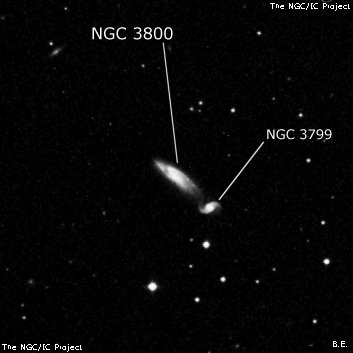
William Herschel discovered NGC 3800 = H II-103 = h936 = h3356 on 8 Apr 1784 (sweep 187) and noted "F, S, E, r. 2 or 3 star visible in it. The nebula is near some small stars." John Herschel made 5 observations at Slough and one at the Cape of Good Hope. His first observation (21 Apr 1832) reads "F; E nf to sp; has another F neb [NGC 3799] attached to its preceding extremity."
Lord Rosse first observed NGC 3800 on 1 Apr 1848 (when the 72" started use after the potatoe blight) and noted "a tolerably bright nebula with a smaller one following."
400/500mm - 17.5" (3/29/89): moderately bright, fairly small, very elongated 3:1 SW-NE, 1.8'x0.5'. Forms a close pair with NGC 3799 just off the SW end 1.4' from the center. A mag 10.5 star is 3.2' SSE of center.
900/1200mm - 48" (3/1/19): at 488x; bright, large, elongated nearly 3:1 SW-NE, 1.7'x0.55', large bright core, very irregular appearance. It appeared the SW portion of the galaxy extended further or was stretched in the direction of the companion NGC 3799 (the pair is Arp 83). The SW outer fringes had a lower surface brightness than the rest of the galaxy as it neared NGC 3799. The galaxy brightened slightly at the NE end of a spiral arm. NGC 3799 is centered 1.3' SW.
Notes by Steve Gottlieb